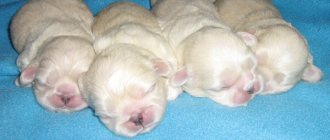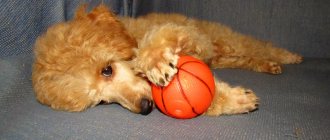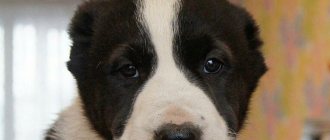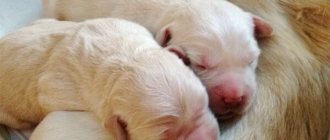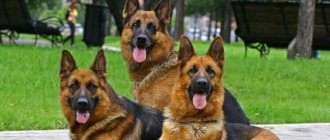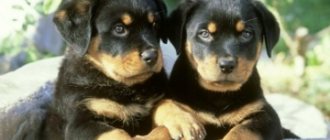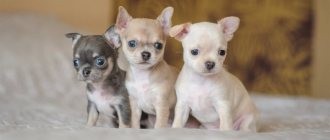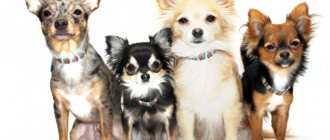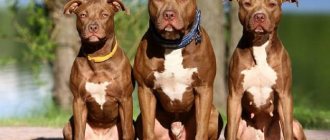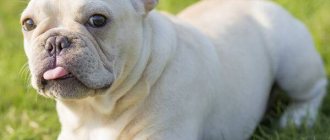The American Pit Bull Terrier, or simply pit bull, is one of the most popular fighting dog breeds today.
These are small, strong dogs, their lifespan is 12-15 years, the most popular colors are black, gray and various shades of brown.
Already from puppyhood, such dogs show all the qualities of a fighter - strength, perseverance, power and stubbornness.
But, like all puppies, pit bull babies are playful, active and friendly.
With proper upbringing, they are sure to grow into loyal friends, guards and companions.
Photos of newborn puppies
Newborn pit bull puppies are small, dense bundles that are unable to see, hear, defecate, or keep themselves warm. The mother does all this for them.
However, their olfactory, sucking and tactile functions are well developed, which allows them to reach the mother’s nipple and receive milk.
A newborn puppy weighs about 250-500 g, and its height is 15-20 cm.
Development from 1 to 12 months
| Age | Size (height) | Weight | Description |
| 1 month | 20-25 cm | 2.5-4 kg | Immediately after birth, the puppy is almost completely dependent on its mother. Of all the reflexes, he only has: sucking, motor, olfactory and tactile. A newborn baby's ears and ears are closed, and there is no thermoregulation. By the end of the first month, the baby's eyes and ears open and he begins to actively explore the world, eat solid food and play with his fellow tribesmen. |
| 2 months | 25-30 cm | 6-9 kg | The 2nd month is called the period of first socialization. At this age, puppies are separated from their mother and find new owners. |
| 3 months | 30-36 cm | 9-14 kg | The baby is actively growing, gaining weight and changing significantly in appearance. At this age, the dog’s future exterior begins to be visible, the musculoskeletal system is actively developing and teeth begin to change. |
| 4-5 months | 35-45 cm | 14-24 kg | The pet grows and develops at a very fast pace, and a relationship between it and the owner begins to be established. At this age, the change of teeth is completed. |
| 6 months | 40-48 cm | 23-28 kg | Early adolescence. The puppy learns the meaning of the hierarchy and tries to find its place in it. At this age, pets can become stubborn and disobedient. Growth and development slow down by the end of the 6th month. |
| 7 months | 45-50 cm | 28-35 kg | The puppy begins to show sexual activity, and also tries to take the highest possible place in the domestic hierarchy. At this time, females are already in heat, and males become more active and can show aggression. |
| 8 months | 48-50 cm | 30-35 kg | At this age, the puppy increasingly takes on the appearance of an adult dog, and also begins to exhibit character traits that will be characteristic of it throughout its life. |
| 9-12 months | 48-50 cm | 30-35 kg | By this age, the pet’s body is almost completely formed. The exterior and character are also formed. If before this time it was not possible to teach the puppy the rules of behavior and commands, now it will be much more difficult to do so. |
Characteristic
The Fédération Cynologique Internationale has not officially recognized the breed. The American Pit Bull Terrier Standard is proposed by the UKC organization:
| Parameter | Description |
| Height | The height of the body slightly exceeds the length of the body |
| Pit bull weight | For males, this figure varies from 20 to 27 kg. The female weighs on average 14-22 kg |
| Head | Rectangular with a wide skull between the ears, convex cheeks, square muzzle, powerful jaws with a scissor bite |
| Frame | Solid with a deep chest, broad strong back, muscular neck, slightly arched loin and slightly retracted belly |
| Eyes | Almond-shaped with a low rise. Any color of the iris is allowed, excluding blue shades of different saturation. Pit bulls over 2 years of age with blue eyes are considered not to fit the breed standard. |
| Ears | Highly placed. Sometimes they are docked |
| Nose | The lobe comes in different colors. An important characteristic is wide open nostrils. |
| Limbs | Muscular, very strong with flexible compact pasterns, powerful thighs |
| Tail | Short, rising to the croup while running |
| Wool | Harsh, short, tightly lying on the skin, shiny. There is no undercoat. It's not on the stomach |
Basic care rules
Caring for your pit bull's cheeks involves following these rules :
- The training and upbringing of a baby begins from the first day it arrives in the house. This applies to: place, rules of behavior, feeding, walks, etc. Such training involves establishing close contact with the dog, as well as a leadership position from the owner.
- Proper nutrition. Balance is very important here; on the one hand, food must contain all the necessary substances, and on the other hand, the norms and rules of feeding must be observed.
- Caring for a pit bull's coat involves bathing several times a year, as well as regular brushing of teeth, ears, and nail trimming.
- In the first year of life, the dog should be regularly shown to the veterinarian, and vaccinations should be given on time, according to the schedule.
- Taking care of your puppy's health also includes regular administration of anthelmintics (once every 4 months), as well as treatment for fleas, lice and ticks.
- We should not forget that the puppy needs physical activity and needs daily walks and active games. You should walk your baby at least 2-3 times a day for 1-1.5 hours.
- Education and training are an integral part of caring for a pitbull puppy, otherwise the dog can become uncontrollable and dangerous.
Character
Despite all its advantages, this dog causes distrust on the part of many people. If you take Sweden, breeding pit bulls is strictly prohibited there. This was also done in some states of America. In other countries, walking these animals is allowed only with muzzles.
The character of a pit bull dog has been formed over a long period. Today this dog has a friendly and balanced temperament. But the hunting instinct has been preserved, thanks to which the dogs cope well with the role of guarding premises, and are also excellent assistants during the hunt.
Pitbull has the following character traits:
- The desire to constantly be useful to the owner - childishly playful, the pit bull at the same time notices all the needs of its owner. Even if he is unwell, the dog will do everything in his power to become useful and earn gratitude.
- Confidence in his own merits - such a noble feeling of a dog is manifested in the fact that even knowing about his superiority, he will never attempt to show it to the members of the family in which he lives.
- Attentiveness and extraordinary prudence - even pit bull puppies have these character traits. Even as children, they want to appear mature and wise.
- Showing favor towards children - a dog of this breed is characterized by strong devotion to its “pack”, be it dogs or people around it. She behaves very carefully with them and will never bite a child, no matter what he does to her.
Pit bulls are good family dogs and can perform a wide range of different services.
Those individuals with mental disorders were not allowed for breeding. Indeed, pit bull puppies, photos of which you can take a good look at here, can turn into dangerous animals if they are not raised correctly. Therefore, animals that could not control themselves and did not distinguish a person from a dog were destroyed. According to this principle, the gradual formation of the breed took place.
How to toilet train your pet?
As a rule, toilet training a puppy occurs in 3 stages.
The first stage begins from the moment the baby appears in the house. Here it is important to train your pet not to shit anywhere, but to go to one place. Usually the role of a toilet is played by a diaper or a tray with filling.
The next stage is going outside. As soon as you start walking your puppy, you should immediately begin toilet training.
NOTE!
To do this, you should walk with the baby until he wants to have a bowel movement. After the job is done, encouragement must follow.
At the third stage, the pet is taught to defecate only outside. Therefore, you will have to walk him 3-4 times a day after meals, and praise him every time if he did everything right.
Upbringing
Taking into account the peculiarities of the behavior and character of the American Pit Bull Terrier, classes with the pet are carried out regularly from an early age of the animal, taking into account the following rules:
- when communicating with a pit bull terrier, you need to be assertive and confident so that the animal perceives the owner as the leader of the pack;
- You cannot show your pet your own fear;
- physical punishment of a pit bull, which can generate anger and aggression in the animal, is excluded;
- commands to the pit bull terrier should be given in a calm, confident tone, without breaking into a scream;
- in the process of raising a pet, each correctly executed command should be rewarded with a treat or affection;
- if the pit bull terrier makes a mistake, it is necessary to immediately correct the pet’s actions so as not to reinforce the wrong skills in the animal;
- prohibit the animal from jumping on the table or bed at home.
How to feed a grown puppy correctly?
A pit bull puppy is fed according to its age; the younger the pet, the more feedings it requires.
Therefore, the number of feedings will be as follows:
- A baby up to 2 months is fed 6 times a day in small portions.
- From 2 to 3 months – the puppy is fed 5 times a day, with portions increasing.
- From 4 to 6 months the dog is fed 4 times a day.
- At 6-8 months, the pet should eat 3 times a day.
- A 9-month-old dog can be switched to 2 meals a day.
IMPORTANT!
A puppy up to 6 months needs more meat than an adult pet, as its body grows quickly and intensively.
Training and danger level
In order for your pit bull terrier to quickly socialize and acquire competent skills and habits, it is recommended to contact a specialist. This is important, since the pet must learn the basics of obedience, for which a general course of animal training is offered.
The next stage is training the pet in commands from the field of protective guard service, for which the pit bull has the necessary abilities: intelligence, discipline, excellent hearing and scent, hunting inclinations.
As a result, the pit bull terrier will be able to restrain aggression, which significantly reduces the level of danger inherent in this breed. It is mandatory to train your pit bull to immediately carry out all commands. This will allow the owner to keep the pet under control in any environment.
One of the rules of training a pit bull terrier, which should be followed strictly and at home in communication, is the prevention of bites. A small pit bull puppy often confuses his hands with toys, eager to try his teeth on them. Experts recommend immediately stopping such attempts by switching the pet’s attention.
Instilling communication skills in a pit bull while the pet is still small reduces the degree of possible manifestations of anger towards people or other animals. They do this gradually, encouraging friendly expressions and taking the pit bull terrier puppy aside when negative moments arise. As the pet grows older, it becomes less dangerous, since the animal acquires the necessary skills to visit public places.
Weekly menu
Monday:
- Breakfast - kefir.
- Lunch – fresh veal with zucchini or carrots.
- Dinner – oatmeal with baked beets.
Tuesday:
- Breakfast – sour milk or yogurt.
- Lunch – buckwheat porridge with boiled or raw lamb.
- Dinner – baked pumpkin.
Wednesday:
- Breakfast – cottage cheese or kefir.
- Lunch – boiled lung.
- Dinner – stewed cabbage and egg.
Thursday:
- Breakfast – low-fat yogurt.
- Lunch - fresh beef with stewed beets.
- Uzhen – oatmeal with scalded liver.
Friday:
- Breakfast – cottage cheese or kefir.
- Lunch – rice porridge with veal heart.
- Dinner – stewed zucchini with egg.
Saturday:
- Breakfast – kefir or yogurt.
- Lunch – a piece of beef.
- Dinner – stewed cabbage with scalded liver.
Sunday:
- Breakfast – low-fat cottage cheese.
- Lunch – fresh veal with carrots.
- Dinner – baked beets.
NOTE!
The Pit Bull Terrier is a dog breed prone to allergies, so each new product should be introduced with caution.
Factors influencing growth
The harmonious development of pit bulls depends on a group of factors:
- genetic predisposition;
- conditions of keeping the mother dog;
- food, living conditions for puppies;
- absence of congenital pathologies, diseases, infections, helminthic infestations.
One of the most important factors is the dog’s nutrition. The simplest option is feed, premium canned food with a high content of natural ingredients. The most economical and varied is natural food. Meat should predominate in the natural diet of a pit bull up to 6 months of age. The menu itself is varied:
- Beef, veal, lamb, offal.
- Low-fat yogurt without additives, kefir, cottage cheese, yogurt.
- Buckwheat, oatmeal, rice porridge.
- Cabbage, carrots, zucchini, beets.
Vaccination schedule
| Age | Required vaccinations |
| 8-10 weeks | Comprehensive vaccination against distemper, parainfluenza, leptospirosis, hepatitis, parvovirus enteritis and adenovirus infection. |
| 12 weeks | Revaccination against the same diseases. |
| 6 months | Rabies vaccination. |
| 12 months | Vaccinations are completely repeated. |
| Annually | The vaccination will be repeated throughout the dog's life. |
Hygiene procedures
It is enough to wash a pit bull puppy 2-3 times a year, observing the following rules:
- You should bathe your pet using a special shampoo designed specifically for puppies.
- Water temperature is approximately 37-38 degrees.
- When bathing a puppy, there should be no drafts in the room.
- After washing, the dog should be rinsed thoroughly to remove any remaining shampoo, then wrapped in a soft towel and dried.
- If necessary, dry the puppy with a hairdryer.
- For 2-3 hours, the pet is not taken outside while bathing and is protected from drafts.
Caring for your puppy also includes brushing its teeth. This is done using a special dog brush and dog paste.
The pet's ears are cleaned weekly using a cotton swab and a special lotion. The ears should be examined about once a week for mites and inflammation.
As for the eyes, they should be clean and clear; minor discharge is removed with a cotton swab dipped in tea leaves.
The pit bull's coat does not require special care; it is enough to wipe its paws during walks and bathe it 2-3 times a year.
The pet's nails are trimmed using a special nail clipper, which can be purchased at a pet store.
American pit bull: description of the breed
When you see a pit bull for the first time, you can immediately understand that this is an unusually strong dog. Representatives of the breed are divided into two types - bulldog type and terriers. Sometimes they are mixed.
The weight of dogs is not strictly limited - it ranges from 12 to 36 kg, but most often individuals of this species are found weighing from 14 to 28 kg. According to the standard, any color is allowed, except for “merle”. The color of pitbull puppies also varies. Coat colors are allowed from pure black and white to brindle, with different markings.
The dog's appearance is stern - the unusual shape of its head with rather wide cheekbones, a powerful jaw and a strong “bull” neck immediately catches the eye. The animal has well-developed muscles and a wide chest. The ears can be docked, but the tail is not docked.
How to choose your future pet?
Under no circumstances should you purchase a puppy on the market or meet with a breeder on neutral territory - this could lead to you purchasing a crossbreed or a sick puppy. This should only be done in a kennel, paying attention to the conditions in which the dogs live, as well as the condition of the pets themselves.
In addition, be sure to ask the breeder to show the babies’ parents and their documents.
IMPORTANT!
When purchasing, be sure to evaluate the health and mental state of the animal.
Signs of a healthy puppy:
- He is cheerful, playful and inquisitive.
- It does not emit an unpleasant odor.
- The eyes and ears of such a baby are clean, and the coat is shiny and glossy.
